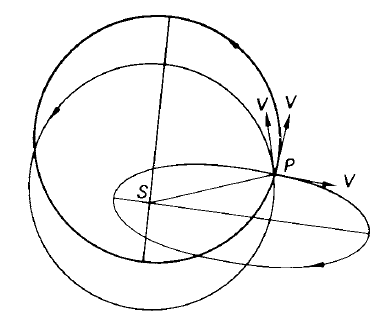
Co-periodic orbits
 المؤلف:
A. Roy, D. Clarke
المؤلف:
A. Roy, D. Clarke
 المصدر:
Astronomy - Principles and Practice 4th ed
المصدر:
Astronomy - Principles and Practice 4th ed
 الجزء والصفحة:
p 181
الجزء والصفحة:
p 181
 12-8-2020
12-8-2020
 2105
2105
Co-periodic orbits
Rewriting equation (1), we have
 (1)
(1)
we obtain
 (2)
(2)
If we eliminate a between equations (1) and (2), there results
 (3)
(3)
Equations (1), (2) and (3) highlight some interesting properties of elliptical motion. It is seen that the semi-major axis is a function of the radius vector and the square of the velocity. If, therefore, a body of mass m1 is projected at a given distance r from another body of mass m2 with

Figure 1. Co-periodic orbits.
velocity V, the semi-major axis a of its orbit is independent of the direction of projection and depends only on the magnitude of the velocity. In figure 13.9, all the orbits have the same initial radius vector SP and the same initial velocity magnitude V though the directions of projection are different. All orbits, therefore, have the same semi-major axis a given by equation (2). It is also seen from equation (3) that the periods in these orbits must also be the same. If particles were projected from P simultaneously into these orbits, they would all pass through P together on return though the orbits they pursued were quite different in shape and not even necessarily in the same plane, as long as the initial radius vector SP and speed V were the same.
 الاكثر قراءة في مواضيع عامة في علم الفلك
الاكثر قراءة في مواضيع عامة في علم الفلك
 اخر الاخبار
اخر الاخبار
اخبار العتبة العباسية المقدسة


